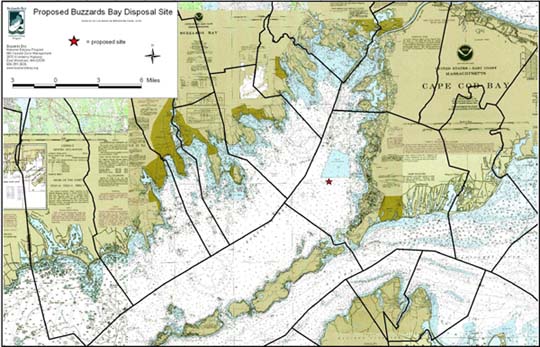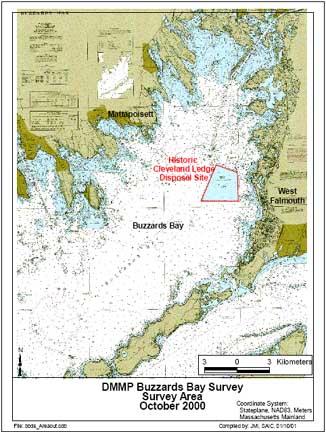Dredging Materials Disposal Information for Buzzards Bay
In the January 2006 Environmental Monitor MCZM announced that that the Buzzards Bay Disposal Site comment period has been extended to February 24, 2006. However in March 2006 the Massachusetts Legislature introduced, and on July 28, 2006 passed Chapter 191 of the Acts of 2006, effectively banning the disposal of dredge materials in Buzzards Bay. This page was originally set up to provide information about the proposed reactivation of the Buzzards Bay dredged materials disposal site.
Background
The are several issues related to dredging in Buzzards Bay that are of interest to residents and municipal officials. These include the dredging of PCB contaminated sediments at the Superfund site in New Bedford Harbor, maintenance dredging by the US Army Corps or Engineers of the Cape Cod Canal, and a new proposed site near the historic Cleveland Ledge disposal area that has been recently identified by the state as a preferred site for the disposal of clean materials. This site is referred to as the proposed Buzzards Bay Disposal Site (BBDS). Information about this designation, and links about other dredging topics, are provided below. Concerns about the potential disposal of contaminated sediments in a relatively clean area of Buzzards Bay led to the 2006 legislative ban on dredged material disposal.
All dredging projects in state waters require a federal wetlands permit from the US Army Corps, a state Water Quality Certificate from MA DEP (see also the DEP application form), and a Chapter 91 permit from MA DEP. If a project meets certain Massachusetts Environmental Policy Act (MEPA) thresholds, it may require a filing through the Massachusetts Executive Office of Environmental Affairs. Many projects also require a Coastal Zone Management Federal Consistency Review. Most state waters are within municipal boundaries, so most dredging projects will have a state wetlands permit (and a local wetlands bylaw permit if applicable) issued by a municipal Conservation Commission. (All of Buzzards Bay is within municipal waters, see map below).
2005 proposed state disposal site for Buzzards Bay
In 2005, the Massachusetts Office of Coastal Zone Management (MCZM) completed development of the Draft Environmental Impact Report (DEIR) titled “Identification and Designation of a Buzzards Bay Disposal Site for Suitable Dredge Material (BBDS)”, and submitted this document to the Massachusetts Environmental Policy Act (MEPA) unit for review. Some of the supporting reports for the DEIR were made available by MCZM in 2001 when they first began identifying a potential dredged material disposal site for Buzzards Bay. As noted on the DEIR, “The intent of the BBDS is to provide a cost-effective, environmentally responsible dredge material disposal alternative in Buzzards Bay for clean dredge material originating from public or private projects in the area. In the early 1990s Massachusetts designated a similar disposal site for clean dredge material in Cape Cod Bay, however the distance to this disposal site makes its use cost prohibitive for many dredging projects in the Buzzards Bay area.” The original deadline for comments to MEPA was December 22, 2005, was then extended to February 24, 2006, as reported in the January 2006 Environmental Monitor, before dredged material disposal was banned.

The proposed designation of a preferred BBDS was not to be an automatic authorization for disposal of dredged materials in Buzzards Bay. All dredging and disposal projects in Buzzards Bay would have still required all applicable local, state, and federal permits, but this was process was viewed as inadequate by opponents of the proposed disposal site.
Below we have kept the links to 2005 Draft Environmental Impact Report (DEIR) for the proposed Buzzards Bay Disposal Site, Identification and Designation of a Buzzards Bay Disposal Site for Suitable Dredged Material EEA No. 10284 as submitted to MEPA because it contains much valuable information about the bottom and ecosystem of Buzzards Bay. The appendixes are not found below. Left-click to open the pdf files in your browser; or right-click to save to a directory on your computer. [Note: Graphics quality has been degraded so that downloaded file sizes are reduced. Obtain the CD if you desire the full resolution version, or to obtain the appendixes. Alternatively, you can go to the Town of Falmouth DEIR webpage for these same files in their original size format and resolution (e.g. Section 3 is 46 MB).]
DEIR Executive Summary (1.9 MB)
DEIR Table of Contents (0.2 MB)
Related: November 2000 Remots® Survey at Two Candidate Dredged Material Disposal Sites in Buzzards Bay (PDF, 3.1M, November 2001)
Concerns raised by some Town of Falmouth officials about the proposed BBDS location is described in this Falmouth Enterprise Story.
US Army Corps of Engineers Cape Cod Canal disposal site studies for Cleveland Ledge
Historically, the US Army Corps of Engineers used a site within the Cleveland Ledge disposal area (the blue shaded trapezoidal polygon on the maps shown here) off West Falmouth. Monitoring and evaluation of this site was funded by the Army Corps.
Army Corps DAMOS program: Monitoring sediments and biota at dredged material disposal sites
Army Corps DAMOS program map
Complete 1990 DAMOS Report for Buzzards Bay (1 MB pdf file)

Other Massachusetts dredging and permitting Links
MCZM’s Port and Harbor Planning and Dredged Materials Management Plan page
Buzzards Bay Comprehensive Conservation and Management Plan action plan on dredging
DEP promulgates new regulations for contaminated materials disposal
In 2006, the MA DEP proposed and then promulgated changes to the regulations that created a new exclusion from the definition of hazardous waste for dredged material subject to a permit and certification under the federal Clean Water Act. According to DEP’s original posting, the changes eliminated regulatory overlap, “while ensuring an accurate and environmentally sound evaluation and management of dredged material.” The current regulations are posted at this DEP 314cmr09.pdf link.